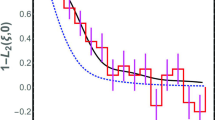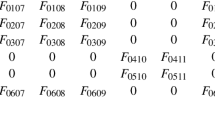Abstract
A stochastic activity-transfer model, previously proposed to apply to turbulence, is studied and simulated on a 256×256 lattice. Introduction of random self-activation does not allow stable fronts to develop in the limit of small growth probability. By assigning discrete density values equal to the threshold values in a related continuous and deterministic model, the structure functions for distancesr in the lattice are calculated. They have a functional form different from the power behavior which in the case of the deterministic version was interpreted as another sign of self-organized criticality. Future studies of these and other models may be facilitated by the algorithm developed for structure function calculations.
Similar content being viewed by others
References
P. Bak and K. Chen, The physics of fractals,Physica D 38:5–12 (1989).
P. Bak, K. Chen, and C. Tang, A forest-fire model and some thoughts on turbulence,Phys. Lett. A 147:297–300 (1990).
P. Bak, C. Tang, and K. Wiesenfeld, Self-organized criticality: An explanation of 1/f noise,Phys. Rev. Lett. 59:381–384 (1987).
K. Christensen, H. C. Fogedby, and H. J. Jensen, Dynamical and spatial aspects of sandpile cellular automata,J. Stat. Phys. 63:653–684 (1991).
P. Grassberger and H. Kantz, On a forest fire model with supposed self-organized criticality,J. Stat. Phys. 63:685–700 (1991).
P. Grassberger, Self-organized criticality, preprint (1990).
K. Chen, P. Bak, and M. H. Jensen, Weak chaos in a turbulent model,Phys. Lett. A 149:207 (1990).
G. Paladin and A. Vulpiani, Anomalous scaling laws in multifractal objects,Phys. Rep. 156:147–225 (1987).
M. H. Jensen, Personal communication (1990).
J. Finjord, Structure functions in a “forest-fire” model of turbulence, inSpontaneous Formation of Space-Time Structures and Criticality, T. Riste and D. Sherrington, eds. (Plenum Press, New York, 1991).
P. Grassberger and S. S. Manna, Some more sandpiles, Preprint WU B 90-5 (1990);J. Phys. (Paris), to appear.
W. H. Press, B. P. Flannery, S. A. Teukolsky, and W. T. Vetterling,Numerical Recipes: The Art of Scientific Computing (FORTRAN Version) (Cambridge University Press, Cambridge, 1989).
NAG Fortran Library Manual, Mark 14 (1990).
Author information
Authors and Affiliations
Rights and permissions
About this article
Cite this article
Finjord, J. Structure functions in a model of turbulent energy dissipation. J Stat Phys 68, 749–760 (1992). https://doi.org/10.1007/BF01048874
Received:
Revised:
Issue Date:
DOI: https://doi.org/10.1007/BF01048874




